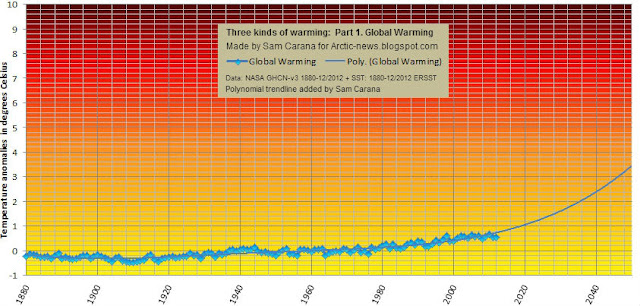What many people may not realize is that temperatures in the Arctic are actually a lot higher than they used to be around this time of year.
Temperatures in the Arctic have risen due to feedbacks as described in the post The Biggest Story of 2013.
As a result, temperature anomalies above 20 degrees Celsius now feature in the Arctic. As the image on the right illustrates, the once-common temperature difference between the Arctic and lower latitudes has been shattered, and this is weakening the Jet Stream and the Polar Vortex, in turn making it easier for cold air to flow down to lower latitudes and for warmer air to enter the Arctic, as described in posts at this blog for years, e.g. this post.
This is illustrated by the image below, showing that the Arctic is hit by an overall temperature anomaly of 6.55 degrees Celsius, while some areas in the Arctic feature anomalies above 20 degrees Celsius.
Forecasts show that on February 2nd, 2014, 1200 UTC, the Arctic will be hit by a temperature anomaly of 7.85 degrees Celsius, while on February 6th, 2014, 1200 UTC, the U.S. will be hit by temperatures as low as -40 degrees, as illustrated by the image below.
The video below shows temperature forecasts from February 1to February 8, 2014.
The video below shows temperatire anomalies from February 2 to February 9, 2014.
Meanwhile, the Gulf Stream keeps pushing warm water into the Arctic Ocean, as illustrated by the image below.
 |
| Click on image to enlarge - view updated animation at earth.nullschool.net |
This has already resulted in methane eruptions from the seafloor of the Arctic Ocean that started several months ago and are continuing to date - ominous signs of more to come. The image below, which compares peak methane levels at two altitudes between January 2013 and January 2014, suggests that January 2014 peak levels have increased strongly, compared to January 2013 peak levels. Furthermore, that the rise in average peak readings has been most dramatic at the higher altitude.
This suggests that huge quantities of methane have indeed been released from hydrates under the Arctic ocean, and that much of the methane is rising and building up at higher altitudes. The increasing appearance of noctilucent clouds further confirms indications that methane concentrations are rising at higher altitudes.
Of course, the above analysis uses a limited dataset, but if verified by further analysis, it would confirm a dramatic rise in the presence of methane in the atmosphere due to releases from hydrates. Moreover, it would confirm the immensity of threat that releases from the Arctic Ocean will escalate and trigger runaway warming, as high methane concentrations over the Arctic are contributing to the anomalously high temperatures there. The risk that this will eventuate is unacceptable, which calls for comprehensive and effective action such as discussed at the ClimatePlan blog.









